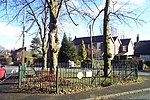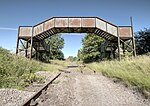Edial Hall School
1730s disestablishments in Great Britain1735 establishments in EnglandDefunct schools in StaffordshireEducational institutions established in 1735Staffordshire building and structure stubs ... and 1 more
West Midlands (region) school stubs

Edial Hall School was a school established in 1735 by Samuel Johnson at Edial, near Lichfield. Here, Johnson taught Latin and Greek to young gentlemen. The funds for the school were provided by his wife, "Tetty" Johnson.It only had three pupils, one of whom was David Garrick, and it was only open for about a year, after which Johnson was forced to close it due to a lack of funds.
Excerpt from the Wikipedia article Edial Hall School (License: CC BY-SA 3.0, Authors, Images).Edial Hall School
Lichfield Road, Lichfield
Geographical coordinates (GPS) Address Nearby Places Show on map
Geographical coordinates (GPS)
| Latitude | Longitude |
|---|---|
| N 52.676 ° | E -1.8817 ° |
Address
Lichfield Road
Lichfield Road
WS7 0HX Lichfield
England, United Kingdom
Open on Google Maps











